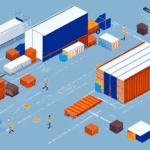Effective Transportation Network Optimization for Business Success
Effective transportation network optimization is critical for businesses looking to maintain their competitive edge, reduce costs, enhance customer satisfaction, and increase sustainability efforts. By taking a strategic approach to transportation network optimization, organizations can improve efficiency, reduce transit times, and uncover new opportunities for growth.
Understanding the Importance of Transportation Network Optimization
Transportation plays a significant role in the supply chain, necessitating smarter management of transportation networks. Transportation network optimization involves evaluating and analyzing transportation resources, including vehicles, carriers, routes, and schedules, to enhance efficiency and reduce costs while boosting service levels.
One key benefit of transportation network optimization is the reduction of carbon emissions and promotion of sustainability. By optimizing routes and schedules, businesses can minimize travel distances and decrease the number of empty or partially loaded vehicles on the road. This not only lowers fuel consumption and emissions but also reduces the environmental impact on local communities.
According to the Environmental Protection Agency, optimizing transportation can significantly decrease greenhouse gas emissions, contributing to broader sustainability goals.
Analyzing and Enhancing Your Current Transportation Network Strategy
Before optimizing a transportation network, it's essential to thoroughly evaluate the existing strategy. This includes assessing current transportation processes and identifying strengths and weaknesses. A comprehensive analysis can reveal areas where small improvements can lead to significant impacts.
Assessing External Factors
Consider the impact of external factors such as weather, traffic, and road conditions, which can greatly affect the efficiency and reliability of your transportation network. Implementing contingency plans to mitigate these impacts is crucial.
Understanding Customer Demand
Analyzing customer demand patterns and delivery requirements can help identify opportunities for optimization and cost savings. Tools like advanced analytics can provide valuable insights into demand forecasting and inventory management.
Key Performance Indicators (KPIs) for Transportation Network Optimization
Key performance indicators are essential for measuring the effectiveness of transportation network optimization strategies. Organizations must identify and track relevant KPIs to ensure continuous improvement and achievement of business goals.
Carbon Emissions
With the increasing focus on sustainability, tracking carbon emissions helps companies identify areas to improve their environmental impact, such as optimizing routes to reduce fuel consumption or using eco-friendly transportation options.
Transportation Costs and Efficiency
Monitoring transportation costs, on-time delivery rates, and transit times are crucial for assessing overall efficiency. These metrics help in identifying cost-saving opportunities and enhancing service reliability.
Customer Satisfaction
Customer satisfaction can be improved by ensuring timely and accurate deliveries. Implementing a Transportation Management System (TMS) can provide real-time updates to customers, enhancing their experience.
Leveraging Technology for Transportation Network Optimization
In today's digital age, technology plays a pivotal role in transportation network optimization. Utilizing Transportation Management Systems (TMS) and other technology solutions can enhance visibility, improve efficiency, and increase profitability.
Real-Time Shipment Tracking
With GPS tracking and advanced technologies, businesses can monitor the location and status of shipments in real-time. This improves visibility, reduces the risk of lost or delayed shipments, and allows for proactive problem-solving.
Data Analytics and Predictive Modeling
Advanced analytical techniques, such as machine learning and predictive analytics, enable organizations to gain insights into transportation performance, predict future trends, and optimize operations with greater accuracy.
According to a report by McKinsey & Company, companies that leverage data analytics in their transportation strategies can achieve significant cost savings and efficiency improvements.
Designing an Efficient and Cost-Effective Transportation Network
Transportation network optimization may involve designing a new network that maximizes efficiency and reduces costs. This includes consolidating inventories, testing various transportation modes, and optimizing distribution centers.
Route Optimization
Utilizing route optimization software can help reduce fuel consumption, minimize delivery times, and enhance overall efficiency. Tools like Geopointe offer advanced route planning capabilities.
Sustainable Transportation Practices
Implementing sustainable practices, such as using electric or hybrid vehicles, can reduce costs and improve environmental sustainability. According to the International Energy Agency, the adoption of electric vehicles is a key driver in reducing transportation-related emissions.
Collaboration and Communication
Effective communication and collaboration between suppliers, carriers, and customers are essential. Sharing information and working together can identify improvement areas and implement mutually beneficial solutions.
Enhancing Customer Experience Through Optimized Transportation Management
Optimized transportation management directly impacts customer satisfaction. Real-time tracking and transparent supply chain processes can reduce errors and improve delivery accuracy.
Real-Time Updates
Providing customers with real-time updates on shipment status enhances transparency and trust. A TMS can facilitate these updates effectively.
Cost Savings and Profitability
Streamlining transportation processes and reducing inefficiencies lead to cost savings, which can be allocated to other business areas, driving profitability and growth.
Increasing Sustainability Through Transportation Network Optimization
Transportation network optimization is a key driver for sustainability and reducing carbon footprints. By reducing miles traveled and optimizing routes, organizations can significantly lower fuel consumption and emissions.
Alternative Transportation Options
Implementing alternative options, such as biking or public transit for employees, reduces the number of vehicles on the road and promotes a healthier lifestyle. Additionally, shifting to electric or hybrid vehicles further diminishes environmental impact.
Optimized Delivery Routes
Optimizing delivery routes not only saves time and costs but also contributes to sustainability. According to the Transport & Environment, route optimization can lead to substantial reductions in greenhouse gas emissions.
Best Practices for Implementing and Maintaining an Optimized Transportation Network
Implementing transportation network optimization strategies requires careful planning, communication, and collaboration with all stakeholders, including carriers, suppliers, and customers.
Utilizing Technology
Adopting a Transportation Management System (TMS) can streamline transportation processes, reduce costs, and improve visibility. A robust TMS provides real-time data and analytics, enabling informed decision-making.
Adapting to Change
Maintaining an optimized transportation network involves adapting to changing circumstances, such as fluctuations in demand, weather conditions, and unforeseen events. A flexible transportation network minimizes disruptions and maintains customer satisfaction.
Regular Assessments
Regularly assessing progress against KPIs allows businesses to identify areas for improvement and implement necessary changes to sustain and enhance their transportation network optimization efforts.
Case Studies of Successful Transportation Network Optimization
Numerous organizations have benefited from effective transportation network optimization strategies, achieving significant improvements in efficiency, cost reduction, and customer satisfaction.
Real-Time Data and Analytics
Companies utilizing real-time data and analytics for routing and scheduling have seen marked improvements. For example, IBM has implemented advanced analytics to enhance their transportation operations, resulting in reduced costs and improved delivery times.
Alternative Transportation Modes
Shifting to alternative modes of transportation, such as rail or water transport, has allowed organizations to decrease reliance on more expensive and less efficient trucking. This approach is particularly effective for transporting large volumes of goods over long distances.
Future Trends in Transportation Network Optimization
Transportation network optimization is continuously evolving, with emerging trends shaping the future of the industry. Businesses must stay abreast of these trends to remain competitive.
Autonomous Vehicles and Robotics
The integration of autonomous vehicles and robotics into transportation networks promises enhanced efficiency and reduced labor costs. These technologies are expected to revolutionize last-mile delivery and reduce human error.
Last-Mile Delivery Solutions
Innovative last-mile delivery solutions, including drone deliveries and automated delivery lockers, are set to transform how goods are delivered to consumers, offering faster and more reliable service.
Sustainable Technologies
Advancements in sustainable technologies, such as electric propulsion systems and alternative fuels, will play a crucial role in reducing the environmental impact of transportation networks.
Measuring the ROI of Transportation Network Optimization
Assessing the return on investment (ROI) of transportation network optimization strategies is essential for justifying the costs associated with implementing these solutions. ROI can be measured through various metrics:
- Cost Reductions: Lower transportation costs through optimized routes and improved efficiency.
- Increased Profitability: Enhanced efficiency and cost savings contribute to higher profit margins.
- Improved Customer Satisfaction: Timely and accurate deliveries lead to higher customer satisfaction and loyalty.
- Reduced Carbon Footprint: Sustainable practices reduce environmental impact, aligning with corporate social responsibility goals.
Regularly reviewing data and KPIs ensures that the optimization strategy remains effective and sustainable, delivering long-term benefits to the organization.
Conclusion
Effective transportation network optimization is an ongoing process that requires a strategic approach, collaboration, and the utilization of advanced technology solutions. By proactively optimizing transportation network management, businesses can stay ahead of the competition, reduce costs, increase efficiency, and enhance customer satisfaction. Implementing a transportation network optimization strategy is essential for businesses seeking a competitive advantage and a sustainable future.






















